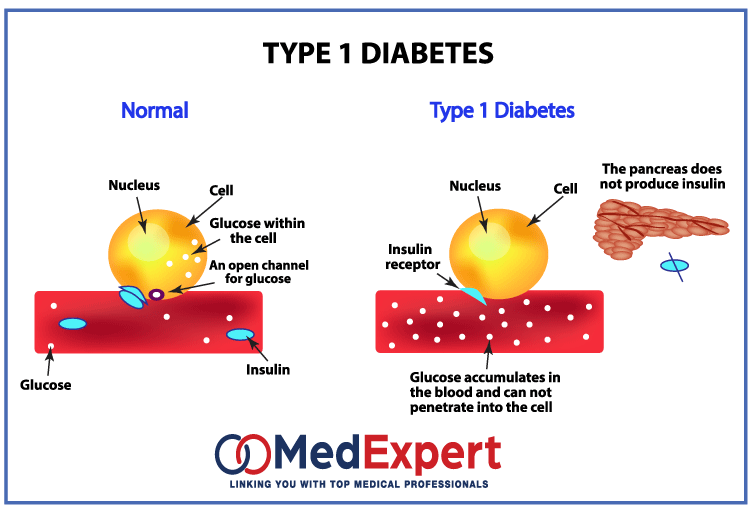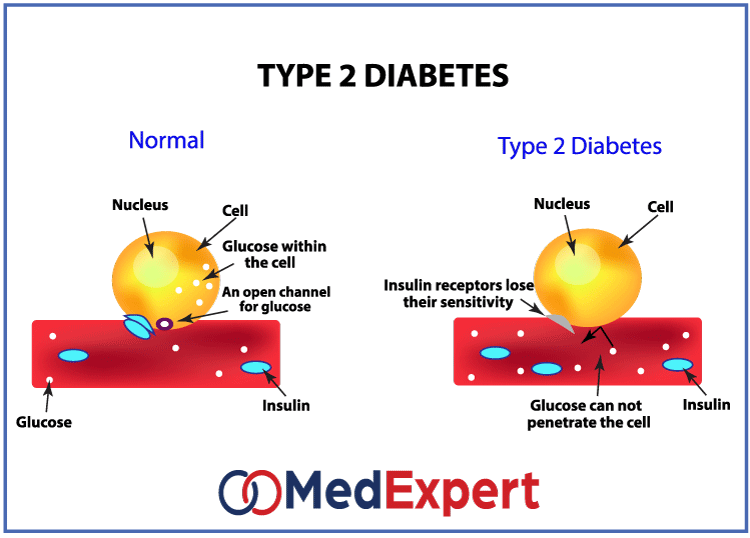DIABETES MELLITUS
Diabetes mellitus is a chronic and usually progressive disease. Diabetes treatment directly depends on its type. Diabetes mellitus symptoms may vary due to blood glucose levels fluctuation and type of the disorder. Determination of diabetes type is crucial, as treatment will be performed in accordance with the type, therefore a very thorough diagnostics shall be performed. Below we will discuss in detail the nature of this disease, as well as its types, including Latent autoimmune diabetes of adults, also know as LADA diabetes, diabetes treatment options and diagnosing protocol.
Diabetes Mellitus is a collection of disorders that affects the amount of glucose in the blood. Glucose is a vital source of energy for the brain and the body’s tissue cells. When someone has diabetes, they have excess levels of glucose in the blood. Chronic diabetes conditions include:
- Type 1 diabetes: Often called juvenile diabetes, Type 1 diabetes is a chronic condition in which the pancreas is not producing sufficient amounts of insulin- the hormone that allows glucose to enter cells in order to produce energy.
- Type 2 diabetes: A condition that affects how the body metabolizes glucose – an important source of energy for the body. Type 2 diabetes causes the body to either resist insulin or doesn’t produce nearly enough to support a normal glucose level.

WHAT IF MY DOCTOR CANNOT DIAGNOSE MY TYPE OF DIABETES?
Latent autoimmune diabetes of adults (LADA diabetes): We had a patient, who was diagnosed to have diabetes for almost 10 years, survived after coma, did her best to manage the condition (counting carbohydrates, checking blood glucose level, etc.), but still failed to keep it under control. Within the 10 years period she went to see quite a number of doctors: endocrinologists, dieticians, some of them diagnosed Type 1 Diabetes, while others said it was Type 2.
The patient was very disappointed and even frustrated, because none of the recommendations and prescribed diabetes treatment options could help her to control and manage her glucose levels and succeed in controlling the condition. She came to us for some other treatments, but at the same time she wanted to get a second opinion on her diagnosis. The doctor, who is one of the best endocrinologists in Singapore, active participant of scientific life, who is continuously being invited to speak in many international meetings all over the world, explained that the main problem was that she does not have either 1 or 2 type of diabetes, she has LADA.
HOW DOES LADA COMPARE TO OTHER DIABETES TYPES?
Sometimes, LADA is referred to as type 1.5 diabetes. Though it is not the official term but it perfectly illustrates the fact that LADA is a form of type 1 diabetes that shares some characteristics with type 2 diabetes.
As it is a type 1 diabetes disorder, the body’s immune system attacks and kills off insulin producing cells.
LADA is often mistaken for type 2 diabetes as it develops over a longer period of time in children or younger adults. On the other hand, type 1 diabetes in children tends to develop quickly (sometimes within the span of a few days) LADA develops on a slower rate, sometimes over a period of years.
A doctor may initially diagnose LADA as type 2 diabetes in patients over the age of thirty five due to the slower onset of diabetes symptoms.
CAN LADA BE MISDIAGNOSED?
Yes, LADA can often be misdiagnosed as type 2 diabetes. This is due to the patient’s age and the slower onset of symptoms.
If LADA is incorrectly diagnosed as type 2 diabetes, this could lead to inappropriate treatment methods that could cause poorer diabetes control and could accelerate the loss of insulin producing ability.
Clues that can give rise to a clinical suspicion of LADA instead of type 2 diabetes include:
- Absence of metabolic syndromefeatures (obesity, high blood pressure and cholesterol levels)
- Uncontrolled hyperglycemia despite using oral agents
- Evidence of other autoimmune diseases (including Graves’ disease and Anaemia)
Some patients with LADA can show features of metabolic syndrome. This may complicate or delay a diagnosis of LADA.

DIABETES MELLITUS SYMPTOMS
Symptoms of diabetes can vary depending on the amount of blood sugar elevation. For chronic diabetes (type 1 and type 2), the symptoms include:
- Extreme thirst (polydipsia)
- Frequent urination (polyuria)
- Extreme hunger (polyphagia)
- Fatigue
- Irritability
- Slow-healing sores
- Frequent gum and skin infections
DIABETES TREATMENT OPTIONS
Treatments for type 1 & 2 diabetes include:
- Insulin Injections: This is used to control blood sugar in patients with type 1 diabetes or patients with type 2 diabetes that can’t be controlled by medication alone.
- Insulin Pump: A small device is worn on the outside of the body. There is a tube that connects a supply of insulin to a catheter that’s inserted under the skin of the abdomen throughout the day. This device attempts to mimic the normal pancreas’s release of insulin, but you must tell the pump how much insulin is required. Insulin is delivered in two ways; (1) a basal rate where continuous, small trickle of insulin that keeps blood glucose stable between meals and overnight or (2) abolus rate which is a much higher rate of insulin is taken before eating to cover the food you plan to eat.
What are the main advantages of insulin pump?
- Increased flexibility in lifestyle
- Insulin delivery is predictable
- Insulin delivery is precise
- Ability to accurately deliver 1/10th of a unit of insulin
- Tighter blood glucose control (while reducing the risk of low blood glucose)
- Episodes of severe hypoglycaemia is reduced
- Wide fluctuations in blood glucose is reduced
- Help to manage the “dawn phenomenon”
Effective and safe use of the pump requires; commitment to checking blood glucose at least 4 times a day (every day), using carbohydrate counting and adjusting the insulin doses according to blood glucose levels, carbohydrate intake, and physical activity.
- Blood sugar measuring: This helps you to monitor and understand the link between blood glucose levels, carbohydrate intake and physical activity.
- Carbohydrate counting: A diet consisting of lesser amounts of animal products and refined carbohydrates (e.g. white bread) is recommended. Learning how to count carbohydrates is essential for knowing how much insulin to administer.
Managing type 2 diabetes includes:
- Eating healthy
- Exercising regularly
- Medication or insulin therapy
- Monitoring blood sugar
DIAGNOSING DIABETES MELLITUS
Treatment and screening of diabetes includes on site:
- Glycated haemoglobin (A1C): A test that shows the patients average blood sugar levels for the last 2-3 months. It measures the proportion of blood sugar connected to haemoglobin – the oxygen-carrying protein in the red blood cells.
- Urinary ACRL
- Digital retinal photography
- Diabetes foot screen
- Body composition and dietetic counselling
- Pre-diabetes screening


